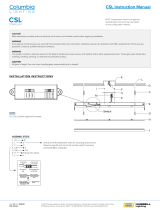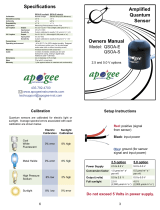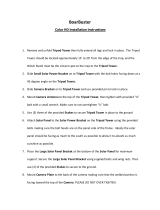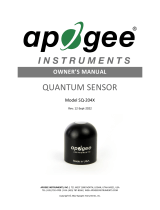Page is loading ...

INSTRUCTION MANUAL
LI190SB Quantum Sensor
Revision: 2/15
Copyright © 1982- 2015
Campbell Scientific, Inc.


Limited Warranty
“Products manufactured by CSI are warranted by CSI to be free from defects in
materials and workmanship under normal use and service for twelve months
from the date of shipment unless otherwise specified in the corresponding
product manual. (Product manuals are available for review online at
www.campbellsci.com.) Products not manufactured by CSI, but that are resold
by CSI, are warranted only to the limits extended by the original manufacturer.
Batteries, fine-wire thermocouples, desiccant, and other consumables have no
warranty. CSI’s obligation under this warranty is limited to repairing or
replacing (at CSI’s option) defective Products, which shall be the sole and
exclusive remedy under this warranty. The Customer assumes all costs of
removing, reinstalling, and shipping defective Products to CSI. CSI will return
such Products by surface carrier prepaid within the continental United States of
America. To all other locations, CSI will return such Products best way CIP
(port of entry) per Incoterms ® 2010. This warranty shall not apply to any
Products which have been subjected to modification, misuse, neglect, improper
service, accidents of nature, or shipping damage. This warranty is in lieu of all
other warranties, expressed or implied. The warranty for installation services
performed by CSI such as programming to customer specifications, electrical
connections to Products manufactured by CSI, and Product specific training, is
part of CSI's product warranty. CSI EXPRESSLY DISCLAIMS AND
EXCLUDES ANY IMPLIED WARRANTIES OF MERCHANTABILITY
OR FITNESS FOR A PARTICULAR PURPOSE. CSI hereby disclaims,
to the fullest extent allowed by applicable law, any and all warranties and
conditions with respect to the Products, whether express, implied or
statutory, other than those expressly provided herein.”

Assistance
Products may not be returned without prior authorization. The following
contact information is for US and international customers residing in countries
served by Campbell Scientific, Inc. directly. Affiliate companies handle
repairs for customers within their territories. Please visit
www.campbellsci.com to determine which Campbell Scientific company serves
your country.
To obtain a Returned Materials Authorization (RMA), contact CAMPBELL
SCIENTIFIC, INC., phone (435) 227-9000. After an application engineer
determines the nature of the problem, an RMA number will be issued. Please
write this number clearly on the outside of the shipping container. Campbell
Scientific’s shipping address is:
CAMPBELL SCIENTIFIC, INC.
RMA#_____
815 West 1800 North
Logan, Utah 84321-1784
For all returns, the customer must fill out a “Statement of Product Cleanliness
and Decontamination” form and comply with the requirements specified in it.
The form is available from our web site at www.campbellsci.com/repair. A
completed form must be either emailed to repair@campbellsci.com or faxed to
(435) 227-9106. Campbell Scientific is unable to process any returns until we
receive this form. If the form is not received within three days of product
receipt or is incomplete, the product will be returned to the customer at the
customer’s expense. Campbell Scientific reserves the right to refuse service on
products that were exposed to contaminants that may cause health or safety
concerns for our employees.

Precautions
DANGER — MANY HAZARDS ARE ASSOCIATED WITH INSTALLING, USING, MAINTAINING, AND WORKING ON OR AROUND
TRIPODS, TOWERS, AND ANY ATTACHMENTS TO TRIPODS AND TOWERS SUCH AS SENSORS, CROSSARMS, ENCLOSURES,
ANTENNAS, ETC. FAILURE TO PROPERLY AND COMPLETELY ASSEMBLE, INSTALL, OPERATE, USE, AND MAINTAIN TRIPODS,
TOWERS, AND ATTACHMENTS, AND FAILURE TO HEED WARNINGS, INCREASES THE RISK OF DEATH, ACCIDENT, SERIOUS
INJURY, PROPERTY DAMAGE, AND PRODUCT FAILURE. TAKE ALL REASONABLE PRECAUTIONS TO AVOID THESE HAZARDS.
CHECK WITH YOUR ORGANIZATION'S SAFETY COORDINATOR (OR POLICY) FOR PROCEDURES AND REQUIRED PROTECTIVE
EQUIPMENT PRIOR TO PERFORMING ANY WORK.
Use tripods, towers, and attachments to tripods and towers only for purposes for which they are designed. Do not exceed design
limits. Be familiar and comply with all instructions provided in product manuals. Manuals are available at www.campbellsci.com or
by telephoning (435) 227-9000 (USA). You are responsible for conformance with governing codes and regulations, including safety
regulations, and the integrity and location of structures or land to which towers, tripods, and any attachments are attached. Installation
sites should be evaluated and approved by a qualified engineer. If questions or concerns arise regarding installation, use, or
maintenance of tripods, towers, attachments, or electrical connections, consult with a licensed and qualified engineer or electrician.
General
• Prior to performing site or installation work, obtain required approvals and permits. Comply
with all governing structure-height regulations, such as those of the FAA in the USA.
• Use only qualified personnel for installation, use, and maintenance of tripods and towers, and
any attachments to tripods and towers. The use of licensed and qualified contractors is
highly recommended.
• Read all applicable instructions carefully and understand procedures thoroughly before
beginning work.
• Wear a hardhat and eye protection, and take other appropriate safety precautions while
working on or around tripods and towers.
• Do not climb tripods or towers at any time, and prohibit climbing by other persons. Take
reasonable precautions to secure tripod and tower sites from trespassers.
• Use only manufacturer recommended parts, materials, and tools.
Utility and Electrical
• You can be killed or sustain serious bodily injury if the tripod, tower, or attachments you are
installing, constructing, using, or maintaining, or a tool, stake, or anchor, come in contact
with overhead or underground utility lines.
• Maintain a distance of at least one-and-one-half times structure height, 20 feet, or the
distance required by applicable law, whichever is greater, between overhead utility lines and
the structure (tripod, tower, attachments, or tools).
• Prior to performing site or installation work, inform all utility companies and have all
underground utilities marked.
• Comply with all electrical codes. Electrical equipment and related grounding devices should
be installed by a licensed and qualified electrician.
Elevated Work and Weather
• Exercise extreme caution when performing elevated work.
• Use appropriate equipment and safety practices.
• During installation and maintenance, keep tower and tripod sites clear of un-trained or non-
essential personnel. Take precautions to prevent elevated tools and objects from dropping.
• Do not perform any work in inclement weather, including wind, rain, snow, lightning, etc.
Maintenance
• Periodically (at least yearly) check for wear and damage, including corrosion, stress cracks,
frayed cables, loose cable clamps, cable tightness, etc. and take necessary corrective actions.
• Periodically (at least yearly) check electrical ground connections.
WHILE EVERY ATTEMPT IS MADE TO EMBODY THE HIGHEST DEGREE OF SAFETY IN ALL CAMPBELL SCIENTIFIC PRODUCTS,
THE CUSTOMER ASSUMES ALL RISK FROM ANY INJURY RESULTING FROM IMPROPER INSTALLATION, USE, OR
MAINTENANCE OF TRIPODS, TOWERS, OR ATTACHMENTS TO TRIPODS AND TOWERS SUCH AS SENSORS, CROSSARMS,
ENCLOSURES, ANTENNAS, ETC.


Table of Contents
PDF viewers: These page numbers refer to the printed version of this document. Use the
PDF reader bookmarks tab for links to specific sections.
1. Introduction ................................................................. 1
2. Cautionary Statements ............................................... 1
3. Initial Inspection ......................................................... 1
3.1 Ships With ............................................................................................ 1
4. Quickstart .................................................................... 2
5. Overview ...................................................................... 4
6. Specifications ............................................................. 6
7. Installation ................................................................... 7
7.1 Mount to a Tripod or Tower................................................................. 7
7.1.1 Tools Required .............................................................................. 7
7.1.2 Mounting Procedure ..................................................................... 7
7.1.2.1 CM225 Solar Sensor Mounting Stand ................................ 7
7.1.2.2 015ARM ............................................................................. 9
7.2 Wiring ................................................................................................ 11
7.3 Programming ...................................................................................... 12
7.3.1 Input Range ................................................................................. 13
7.3.2 Multiplier .................................................................................... 14
7.4 Output Format Considerations ........................................................... 14
8. Maintenance and Calibration ................................... 14
9. Troubleshooting........................................................ 15
10. Acknowledgements .................................................. 15
Appendices
A.
Importing Short Cut Code Into a Program
Editor ..................................................................... A-1
B. Example Program ................................................... B-1
B.1 Example CR1000 Program .............................................................. B-1
i

Table of Contents
Figures
5-1. LI190SB spectral response .................................................................. 5
5-2. LI190SB Quantum Sensor with –PT cable termination option ........... 5
7-1. LI190SB schematic ........................................................................... 11
7-2. Differential measurement connection ................................................ 13
7-3. Single-ended measurement connection ............................................. 13
Tables
7-1. Connections to Campbell Scientific Dataloggers .............................. 11
7-2. Multiplier Required for Flux Density and Total Fluxes .................... 14
B-1. Wiring for Example Programs ........................................................ B-1
ii

LI190SB Quantum Sensor
1. Introduction
The LI190SB accurately measures Photosynthetic Photon Flux Density (PPFD)
in both natural and artificial light. PPFD is the number of photons in the 400 to
700 nm waveband incident per unit time on a unit surface. Because PPFD
describes photosynthetic activity, the LI190SB is ideal for growth chambers
and greenhouses.
This manual provides information only for CRBasic dataloggers.
It is also compatible with most of our retired Edlog dataloggers.
For Edlog datalogger support, see an older manual at
www.campbellsci.com/old-manuals or contact a Campbell
Scientific application engineer for assistance.
2. Cautionary Statements
• READ AND UNDERSTAND the Precautions section at the front of this
manual.
• Care should be taken when opening the shipping package to not damage or
cut the cable jacket. If damage to the cable is suspected, consult with a
Campbell Scientific application engineer.
• Although the LI190SB is rugged, it should be handled as a precision
scientific instrument.
• The black outer jacket of the cable is Santoprene® rubber. This
compound was chosen for its resistance to temperature extremes, moisture,
and UV degradation. However, this jacket will support combustion in air.
It is rated as slow burning when tested according to U.L. 94 H.B. and will
pass FMVSS302. Local fire codes may preclude its use inside buildings.
3. Initial Inspection
• Upon receipt of the LI190SB, inspect the packaging and contents for
damage. File damage claims with the shipping company.
• The model number and cable length are printed on a label at the
connection end of the cable. Check this information against the shipping
documents to ensure the correct product and cable length are received.
3.1 Ships With
• (1) ResourceDVD or Instruction Manual
• (1) Calibration Sheet
NOTE
1

LI190SB Quantum Sensor
The calibration sheet shipped with each sensor includes a serial
number and calibration constant. The calibration constant is
unique for each sensor, and is used to compute the multiplier for
the measurement instruction in the datalogger program.
4. Quickstart
Short Cut is an easy way to program your datalogger to measure the LI190SB
and assign datalogger wiring terminals. The following procedures shows using
Short Cut to program the LI190SB.
1. Install Short Cut by clicking on the install file icon. Get the install file
from either www.campbellsci.com, the ResourceDVD, or find it in
installations of LoggerNet, PC200W, PC400, or RTDAQ software.
2. The Short Cut installation should place a Short Cut icon on the desktop of
your computer. To open Short Cut, click on this icon.
3. When Short Cut opens, select New Program.
NOTE
2

LI190SB Quantum Sensor
4. Select Datalogger Model and Scan Interval (default of 5 seconds is OK
for most applications). Click Next.
5. Under the Available Sensors and Devices list, select the Sensors | Solar
Radiation folder. Select LI190SB Quantum Sensor. Click to move
the selection to the Selected device window. Enter the LI190SB Output
that is provided on the calibration sheet shipped with the sensor. This
value is unique to the individual sensor. The PAR flux density defaults to
µmol/m^2 and the PAR total flux defaults to mmol/m^2. This can be
changed by clicking the Flux Density or Total Flux box and selecting one
of the other options.
3

LI190SB Quantum Sensor
6. After selecting the sensor, click at the left of the screen on Wiring
Diagram to see how the sensor is to be wired to the datalogger. The
wiring diagram can be printed out now or after more sensors are added.
7. Select any other sensors you have, then finish the remaining Short Cut
steps to complete the program. The remaining steps are outlined in Short
Cut Help, which is accessed by clicking on Help | Contents |
Programming Steps.
8. If LoggerNet, PC400, RTDAQ, or PC200W is running on your PC, and the
PC to datalogger connection is active, you can click Finish in Short Cut
and you will be prompted to send the program just created to the
datalogger.
9. If the sensor is connected to the datalogger, as shown in the wiring
diagram in step 6, check the output of the sensor in the datalogger support
software data display to make sure it is making reasonable measurements.
5. Overview
The LI190SB quantum sensor measures photosynthetically active radiation
(PAR) in the 400 to 700 nm waveband. The unit of measurement is µmoles per
second per square meter (µmol s
–1
m
–2
).
The quantum sensor is designed to measure PAR received on a plane surface.
The indicated sensor response (FIGURE 5-1) is selected because it
approximates the photosynthetic response of plants for which data are
available. A silicon photodiode with an enhanced response in the visible
wavelengths is used as the sensor. A visible bandpass interference filter in
combination with colored glass filters is mounted in a cosine corrected head.
Measuring PAR within plant canopies, greenhouses, controlled environment
chambers, confined laboratory conditions, or at remote environmental
monitoring sites are all typical applications for this sensor.
4

LI190SB Quantum Sensor
During the night, the LI190SB may output a slightly negative value, caused by
RF noise. Negative values may be set to zero in the datalogger program.
FIGURE 5-1. LI190SB spectral response
The –L portion of the model number indicates that the LI109SB has a user-
specified cable length. Its cables can terminate in:
• Pigtails that connect directly to a Campbell Scientific datalogger
(cable termination option –PT; see FIGURE 5-2).
• Connector that attaches to a prewired enclosure (cable termination
option –PW).
• Connector that attaches to a CWS900-series interface (cable
termination option –CWS). Connection to a CWS900-series interface
allows this sensor to be used in a wireless sensor network.
FIGURE 5-2. LI190SB Quantum Sensor with –PT cable termination
option
5

LI190SB Quantum Sensor
6. Specifications
Features:
• Ideal for growth chambers and greenhouses
• Measures Photosynthetic Photon Flux Density (PPFD) in both natural
and artificial light
• Compatible with Campbell Scientific CRBasic dataloggers: CR6,
CR800, CR850, CR1000, CR3000, CR5000, and CR9000(X)
Stability: < ±2% change over a 1 year period
Response Time: 10 µs
Temperature Dependence: 0.15% per °C maximum
Cosine Correction: Cosine corrected up to 80° angle of incidence
Operating Temperature: –40 to 65 °C
Relative Humidity: 0 to 100%
Detector: High stability silicon photovoltaic detector
(blue enhanced)
Sensor Housing: Weatherproof anodized aluminum case with
acrylic diffuser and stainless steel hardware
Size: 2.38 cm dia x 2.54 cm H (0.94 in dia x 1.00 in H)
Weight: 28 g (1 oz)
Calibration: ±5% traceable to the U.S. National Institute of
Standards Technology (NIST)
Sensitivity: Typically 5 µA per 1000 µmoles s
–1
m
–2
Linearity: Maximum deviation of 1% up to 10,000
µmoles s
–1
m
–2
Shunt Resistor: 604 ohms
Light Spectrum Waveband: 400 to 700 nm
6

LI190SB Quantum Sensor
7. Installation
If you are programming your datalogger with Short Cut, skip Section 7.2,
Wiring
(p.11), and Section 7.3, Programming (p. 12). Short Cut does this work for
you. See Section 4, Quickstart
(p. 24), for a Short Cut tutorial.
7.1 Mount to a Tripod or Tower
7.1.1 Tools Required
Tools required for installation on a tripod or tower using a CM225 Mounting
Stand and LI2003S Leveling Base:
Small and medium Phillips screwdrivers
1/2 inch open end wrench
Tape measure
UV-resistant wire ties
Side-cut pliers
Compass
Step ladder
7.1.2 Mounting Procedure
7.1.2.1 CM225 Solar Sensor Mounting Stand
The CM225 should never be mounted directly to a vertical
pipe. Instead the CM225 should be mounted to a crossarm.
This avoids reflections from the vertical pipe onto the
sensor.
1. Mount the crossarm to the tripod or tower.
2. Place the CM225’s U-bolt in the bottom holes and secure the CM225 to
the crossarm by tightening the U-bolt nuts.
CAUTION
CM225 Stand
CM200 Series
Crossarm
U-bolt Nuts
Mounting Screws
7

LI190SB Quantum Sensor
3. Place the LI190SB in the center of the LI2003S base/leveling fixture.
4. Loosely mount the LI2003S base/leveling fixture on the CM225. Do not
fully tighten the three mounting screws.
5. Turn the leveling screws as required to bring the bubble of the bubble level
within the ring.
6. Tighten the mounting screws to secure the assembly in its final position.
Check that the pyranometer is still correctly leveled and adjust as
necessary.
7. Route the sensor cable along the underside of the crossarm to the
tripod/tower, and to the instrument enclosure.
8. Secure the cable to the crossarm and mast using cable ties.
9. Remove the red cap after installing the sensor. Save this cap for shipping
or storing the sensor.
Bubble Level
Holes for
Mounting Screws
LI2003S Base
Leveling
Screws
Leveling
Screws
Bubble
Level
8

LI190SB Quantum Sensor
7.1.2.2 015ARM
1. Secure the 015ARM to the mast by tightening the U-bolt nuts.
2. Place the LI190SB in the center of the LI2003S base/leveling fixture.
U-bolt Nuts
015ARM
Bubble Level
Holes for
Mounting Screws
LI2003S Base
Leveling
Screws
9

LI190SB Quantum Sensor
3. Loosely mount the LI2003S base/leveling fixture on the 015ARM. Do not
fully tighten the three mounting screws.
Bubble Level
LI190SB
Leveling Screws
Cable Tie
LI2003S
015ARM
Mounting Screws
Holes for
Mounting Screws
10

LI190SB Quantum Sensor
4. Turn the leveling screws as required to bring the bubble of the bubble level
within the ring.
5. Tighten the mounting screws to secure the assembly in its final position.
Check that the pyranometer is still correctly leveled and adjust as
necessary.
6. Route the sensor cable along the underside of the 015ARM’s arm to the
tripod/tower, and to the instrument enclosure.
7. Secure the cable to the mounting arm and mast using cable ties.
8. Remove the red cap after installing the sensor. Save this cap for shipping
or storing the sensor.
7.2 Wiring
A schematic diagram of the LI190SB is shown in FIGURE 7-1.
Connections to Campbell Scientific dataloggers are given in TABLE 7-1.
When Short Cut software is used to create the datalogger program, the sensor
should be wired to the channels shown in the wiring diagram created by Short
Cut.
TABLE 7-1. Connections to Campbell Scientific Dataloggers
Color
Description
CR6, CR9000(X),
CR5000, CR3000,
CR1000, CR800, CR850
Red Signal Differential High
Black Signal Reference Differential Low
Clear Shield
⏚
*Jumper to AG or ⏚ with user supplied wire.
FIGURE 7-1. LI190SB schematic
11

LI190SB Quantum Sensor
7.3 Programming
Short Cut is the best source for up-to-date datalogger programming code.
Programming code is needed
• when creating a program for a new datalogger installation
• when adding sensors to an existing datalogger program
If your data acquisition requirements are simple, you can probably create and
maintain a datalogger program exclusively with Short Cut. If your data
acquisition needs are more complex, the files that Short Cut creates are a great
source for programming code to start a new program or add to an existing
custom program.
Short Cut cannot edit programs after they are imported and edited
in CRBasic Editor.
A Short Cut tutorial is available in Section 4, Quickstart (p. 2). If you wish to
import Short Cut code into CRBasic Editor to create or add to a customized
program, follow the procedure in Appendix A, Importing Short Cut Code Into
a Program Editor
(p. A-1). Programming basics for CRBasic dataloggers are
provided in the following sections. A complete program example for a
CRBasic datalogger can be found in Appendix B, Example Program
(p. B-1).
Programming basics and programming examples for Edlog dataloggers are
provided at www.campbellsci.com/old-manuals.
Output from the LI190SB is a voltage ranging from 0 to a maximum of 10 mV
depending on sensor calibration and radiation level, which is measured by the
datalogger using a differential analog input channel. To measure the output,
CRBasic dataloggers are programmed with the VoltDiff() Instruction.
Nearby ac power lines, electric pumps, or motors can be a source of electrical
noise. If the sensor or datalogger is located in an electrically noisy
environment, the measurement should be made with the 60 or 50 Hz rejection
integration option as shown in the example programs.
Solar radiation can be reported as an average flux density (µmole s
–1
m
–2
) or
daily total flux density (mmoles m
–2
). The appropriate multipliers are listed in
TABLE 7-2.
If a differential channel is not available, a single-ended measurement is a
possibility; the VoltSE() CRBasic instruction is used to make single-ended
measurements. As a test, wire the LI190SB as shown in FIGURE 7-2 and
make single-ended and differential measurements. Compare the results to
determine the acceptability of a single ended measurement.
NOTE
12
/




